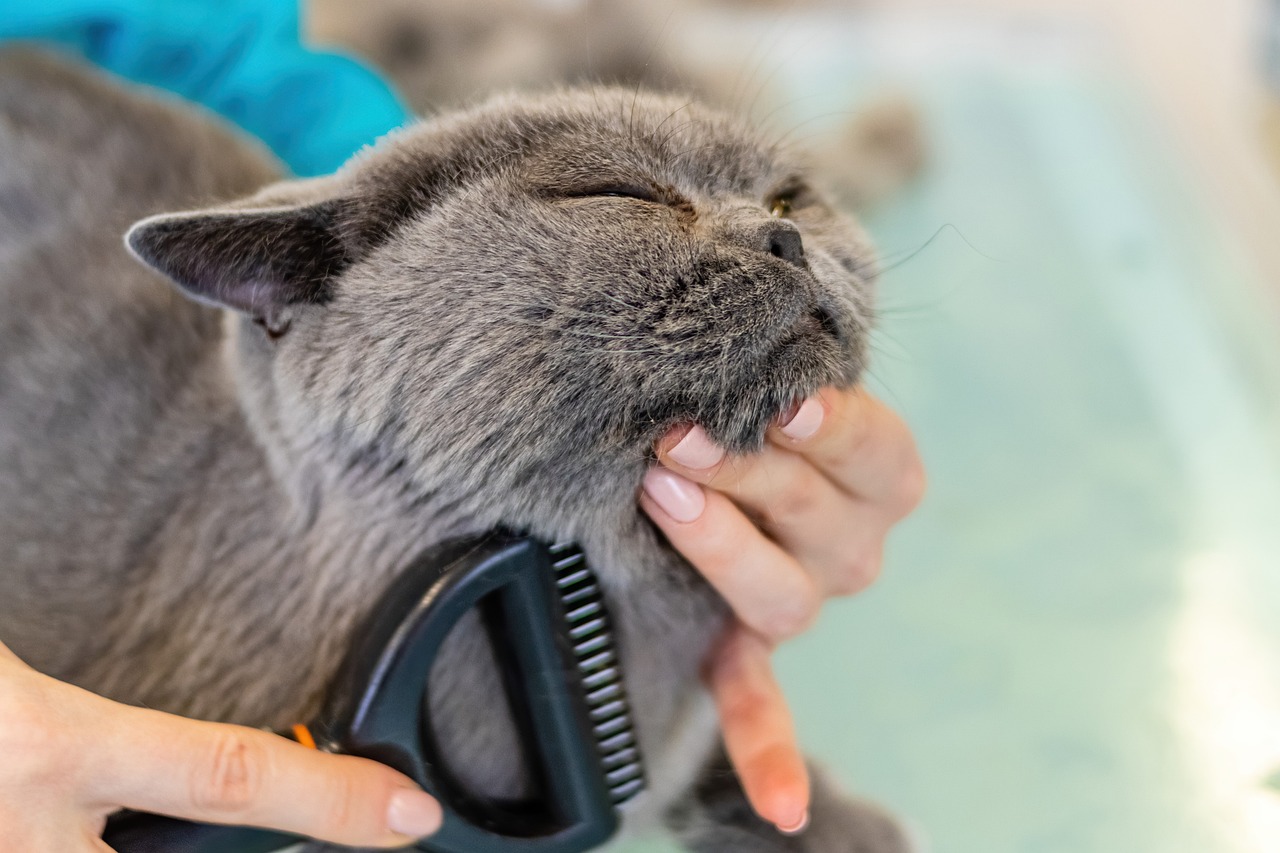When to Consider Palliative Care for Your Aging Pet
As our furry companions age, they often face a myriad of health challenges that can affect their quality of life. Just like us, pets can experience discomfort, chronic pain, and emotional distress as they grow older. This is where palliative care comes into play, offering a compassionate approach to ensure that our beloved pets can live their golden years with dignity and comfort. So, when should you start considering this specialized care for your aging pet?
Recognizing the right time for palliative care can be a game-changer. It's not just about treating illnesses; it’s about enhancing the overall well-being of your pet. Imagine your pet as a cherished family member who deserves the best possible support as they navigate through their twilight years. Palliative care focuses on relieving symptoms and reducing stress, rather than attempting to cure the underlying disease. This means that even if your pet is facing a terminal condition, there are still ways to improve their quality of life.
One of the most significant aspects of palliative care is its holistic approach. It considers not only the physical symptoms but also the emotional and psychological needs of your pet. For many pet owners, the decision to pursue palliative care can be overwhelming. You might find yourself asking, “Is it time?” or “What signs should I look for?” Understanding the principles of palliative care can help you make informed choices that prioritize your pet's comfort and happiness.
In the following sections, we will delve deeper into the signs that indicate your pet may benefit from palliative care, including chronic pain management, nutritional support, and emotional well-being. By being proactive and attentive to your pet’s needs, you can ensure they receive the love and care they deserve during this critical phase of their life.
Palliative care is all about comfort and quality of life. Unlike curative treatments that aim to eliminate disease, palliative care focuses on providing relief from the symptoms and stress associated with serious illnesses. This approach is particularly important for pets diagnosed with terminal conditions where traditional treatments may no longer be effective or appropriate.
Imagine a scenario where your pet is experiencing chronic pain or discomfort due to an illness. Palliative care steps in to ensure that your pet is as comfortable as possible, utilizing a variety of methods to alleviate suffering. This could involve pain management strategies, nutritional support, and emotional care, all tailored to meet your pet's unique needs. It’s a compassionate choice that emphasizes living well, even when facing significant health challenges.
Recognizing the signs that your pet may need palliative care is crucial for enhancing their quality of life. Some common indicators include:
- Chronic pain: If your pet seems to be in pain more often than not, it might be time to consider palliative care.
- Loss of appetite: A sudden change in eating habits can indicate discomfort or illness.
- Decreased mobility: If your pet is struggling to move around or engage in activities they once enjoyed, it’s a red flag.
Being observant and responsive to these changes can make a significant difference in your pet's well-being.
Managing chronic pain is a key component of palliative care. It's heartbreaking to see your pet in discomfort, and knowing how to alleviate that pain can be incredibly empowering. Effective pain relief strategies can include:
There are various medications available that can be prescribed for pain management in pets. Common options include non-steroidal anti-inflammatory drugs (NSAIDs), opioids, and other analgesics. Each of these medications has its own benefits and potential side effects, so it's essential to consult with your veterinarian to determine the best approach for your pet.
In addition to traditional medications, alternative therapies such as acupuncture, physical therapy, and even massage can provide significant relief. These therapies can complement conventional treatments, helping to improve your pet's quality of life. Imagine your pet enjoying gentle stretching or soothing acupuncture sessions that ease their pain and enhance their mobility!
Proper nutrition plays a vital role in supporting aging pets. Dietary adjustments and supplements can enhance your pet's overall health and well-being during palliative care. It's essential to provide balanced meals that cater to their specific needs, potentially including high-quality proteins and easily digestible ingredients.
Palliative care extends beyond physical health; emotional support is equally important. Both pets and their owners can experience a whirlwind of emotions during this time. Providing comfort and companionship can help ease the journey for everyone involved.
A calm and soothing environment can significantly impact your pet's well-being. Consider creating a peaceful space filled with their favorite blankets, toys, and perhaps even a cozy bed near where the family gathers. This familiar setting can provide a sense of security and comfort.
Coping with the impending loss of a beloved pet is never easy. It's essential to acknowledge your feelings and seek support from friends, family, or even professional counselors. Strategies such as journaling, joining support groups, or simply sharing your experiences with others can help you navigate through this challenging journey.
Q: What is the primary goal of palliative care for pets?
A: The primary goal of palliative care is to enhance the quality of life for pets facing serious illnesses by providing relief from symptoms and emotional support.
Q: How can I tell if my pet is in pain?
A: Signs of pain in pets can include changes in behavior, decreased activity, vocalization, and changes in eating or drinking habits.
Q: Is palliative care the same as hospice care?
A: While both focus on comfort, hospice care is specifically for pets in the final stages of life, whereas palliative care can be applied at any stage of a serious illness.
Q: Can palliative care be combined with curative treatments?
A: Yes, palliative care can be used alongside curative treatments to improve your pet's comfort during their illness.
In conclusion, considering palliative care for your aging pet is an act of love and compassion. By being aware of the signs and understanding the options available, you can make informed decisions that prioritize your pet's comfort and happiness.

Understanding Palliative Care
Palliative care is a compassionate approach that focuses on enhancing the quality of life for pets facing serious illnesses, particularly as they age. Unlike curative treatments that aim to eradicate disease, palliative care is all about providing relief from symptoms and alleviating stress. Imagine it as a warm blanket on a chilly night, wrapping your beloved pet in comfort and peace. This approach is designed to support not just the physical health of your pet but also their emotional and psychological well-being.
One of the key principles of palliative care is to prioritize the pet's comfort. This means that rather than pursuing aggressive treatments that may cause more pain than relief, the focus shifts to managing symptoms effectively. For example, if your furry friend is dealing with chronic pain, palliative care will seek to minimize that discomfort through various methods, ensuring they can enjoy their remaining time with you as much as possible.
It’s important to understand that palliative care can be implemented alongside other treatments. In fact, many veterinarians recommend integrating palliative care with curative efforts, especially for conditions that may not be immediately life-threatening but are significantly affecting your pet’s quality of life. This holistic approach allows for a more comprehensive treatment plan that addresses both the physical and emotional needs of your pet.
In essence, palliative care is about making your pet's life as fulfilling and comfortable as possible during their golden years. It involves a collaborative effort between pet owners and veterinarians to tailor a care plan that respects the pet's wishes and needs. Here are some key components that define palliative care:
- Symptom Management: Focused on alleviating pain, nausea, and other distressing symptoms.
- Emotional Support: Providing comfort and companionship to both pets and their owners.
- Quality of Life Assessment: Regular evaluations to ensure the pet’s needs are being met.
- Family Involvement: Encouraging the family to be active participants in the care process.
In conclusion, understanding palliative care is crucial for pet owners who wish to provide their aging companions with the best possible quality of life. It’s about embracing the journey, cherishing the moments, and ensuring that your pet feels loved and cared for until the very end. Your furry friend deserves nothing less.

Signs Your Pet Needs Palliative Care
As pet owners, we often find ourselves in a whirlwind of emotions when it comes to the health of our furry companions. Recognizing when your pet may benefit from palliative care is crucial for ensuring their comfort and quality of life. It’s not always easy to spot the signs, but being attuned to your pet’s behavior can make all the difference. So, what should you look for? Let’s dive into some common indicators that your beloved pet might need specialized care.
One of the most significant signs that your pet may require palliative care is a noticeable change in their appetite. If your once-enthusiastic eater suddenly shows disinterest in food or struggles to finish their meals, it could be a signal that something is amiss. Weight loss can follow, leading to further complications. Pay close attention to their eating habits; a lack of appetite can be a cry for help.
Another red flag is decreased mobility. If your pet is having difficulty getting up, walking, or playing as they used to, it could indicate underlying issues such as arthritis or other chronic pain conditions. A once-active dog that now prefers to lounge around is a clear sign that they might be experiencing discomfort. It’s heartbreaking to see our pets slow down, but this can be an important moment to consider their well-being.
Chronic pain is often a silent struggle for pets. If you notice your furry friend whining, whimpering, or showing signs of distress when moving, it's time to take action. Behavioral changes can also be telling. Is your pet becoming more withdrawn or irritable? These emotional shifts can be a response to pain or discomfort, and they deserve our attention.
Let’s not forget about the importance of regular veterinary check-ups. Your vet can provide valuable insight into your pet’s health status and help identify potential concerns early on. They can also assist in differentiating between normal aging signs and those that warrant palliative care.
To summarize, here are some critical signs that may indicate your pet needs palliative care:
- Loss of appetite: Not eating or finishing meals.
- Decreased mobility: Difficulty in movement or reluctance to engage in activities.
- Chronic pain: Whining, whimpering, or signs of distress.
- Behavioral changes: Increased irritability or withdrawal.
Being proactive and recognizing these signs can significantly enhance your pet’s quality of life. If you notice any of these symptoms, don’t hesitate to consult your veterinarian. They can guide you in making the best decisions for your pet’s health and comfort.
1. What is palliative care for pets?
Palliative care focuses on providing relief from symptoms and stress associated with serious illnesses in pets. It aims to improve the quality of life without necessarily trying to cure the underlying disease.
2. How do I know if my pet needs palliative care?
Look for signs such as loss of appetite, decreased mobility, chronic pain, and behavioral changes. If you notice these symptoms, consult your veterinarian for guidance.
3. Can palliative care be combined with other treatments?
Yes! Palliative care can be used alongside curative treatments to help manage pain and improve the quality of life for pets undergoing serious medical conditions.
4. How can I support my pet during palliative care?
Creating a comfortable environment, providing emotional support, and ensuring proper nutrition are all essential aspects of supporting your pet through palliative care.
Chronic Pain Management
When it comes to our aging pets, one of the most heartbreaking realities we face is the potential for chronic pain. As they gracefully age, our furry friends may experience a range of ailments that can lead to discomfort and suffering. This is where becomes an essential aspect of palliative care. The goal is simple yet profound: to ensure our beloved companions can enjoy their golden years with as much comfort and joy as possible.
Chronic pain can manifest in various ways, from limping and reluctance to move to signs of distress when being touched. Recognizing these signs early on can make a world of difference. It’s crucial to consult a veterinarian who specializes in palliative care to develop a tailored pain management plan. This plan may include a combination of medications, alternative therapies, and lifestyle adjustments. Each pet is unique, and what works for one may not work for another, making personalized care vital.
Medications are often the first line of defense in managing chronic pain. Non-steroidal anti-inflammatory drugs (NSAIDs) are commonly prescribed to help alleviate discomfort. However, it’s important to monitor your pet closely for any side effects, which can include gastrointestinal issues or changes in behavior. Regular check-ups with your vet can help ensure that your pet remains safe and comfortable throughout their treatment.
In addition to medications, alternative therapies can play a significant role in pain management. Techniques such as acupuncture and physical therapy have gained popularity in recent years. Acupuncture, for instance, involves inserting thin needles into specific points on the body to relieve pain and improve overall well-being. Many pet owners report noticeable improvements in their pets' comfort levels after just a few sessions. Similarly, physical therapy can help strengthen muscles and improve mobility, allowing pets to regain some of their lost vitality.
Here’s a quick overview of some common pain relief strategies:
| Strategy | Description | Benefits |
|---|---|---|
| Medications | NSAIDs and other pain relief medications | Reduces inflammation and alleviates pain |
| Acupuncture | Inserting needles at specific points | Enhances comfort and promotes healing |
| Physical Therapy | Exercises and treatments to improve mobility | Strengthens muscles and boosts energy |
As we navigate the complexities of chronic pain management, it’s essential to maintain an open line of communication with your veterinarian. They can guide you through the maze of options, helping you to make informed decisions that prioritize your pet's comfort and quality of life. Remember, the journey of palliative care is not just about managing pain; it’s about enhancing the overall experience for your pet as they age gracefully by your side.
In conclusion, managing chronic pain in aging pets is a multifaceted approach that requires attention, compassion, and expertise. By understanding the available options and working closely with veterinary professionals, you can ensure that your beloved companion enjoys their twilight years with dignity and comfort.
- What are the signs of chronic pain in pets? Look for changes in behavior, reluctance to move, and signs of distress when touched.
- Can alternative therapies help with pain management? Yes, therapies like acupuncture and physical therapy can provide significant relief and improve quality of life.
- How can I tell if my pet's medication is working? Monitor your pet for signs of improved comfort, mobility, and overall well-being.
- Is it safe to use over-the-counter pain relief for pets? Always consult your veterinarian before giving any medication to ensure it’s safe and appropriate for your pet.
Medications for Pain Relief
When it comes to ensuring that your aging pet lives their golden years in comfort, understanding the variety of medications available for pain relief is crucial. Just like humans, pets can experience chronic pain due to various conditions such as arthritis, dental issues, or even cancer. The goal of pain relief medications is not only to alleviate discomfort but also to improve your pet's overall quality of life. So, what options do you have?
One of the most common types of medications prescribed for pets includes non-steroidal anti-inflammatory drugs (NSAIDs). These medications work by reducing inflammation and providing pain relief. Some popular NSAIDs for pets are:
- Carprofen - Often used for osteoarthritis and post-surgical pain.
- Deracoxib - Effective for managing pain and inflammation.
- Firocoxib - A newer option that helps with chronic pain management.
While these medications can be highly effective, they aren't without potential side effects. It's important to monitor your pet for any adverse reactions, such as gastrointestinal issues or changes in behavior. Regular check-ups with your veterinarian can help ensure that your pet is tolerating the medication well.
In addition to NSAIDs, your veterinarian may also recommend opioids for more severe pain. These medications, such as tramadol, can provide significant relief for pets suffering from intense discomfort. However, they come with their own set of considerations, including the potential for sedation and dependence, which makes it essential to follow your vet's guidance closely.
Another category of pain management includes adjuvant medications, which are typically used in conjunction with NSAIDs or opioids. These can include:
- Amitriptyline - Primarily an antidepressant, it can also help manage pain.
- Gabapentin - Often used for neuropathic pain, it can be a game-changer for some pets.
As you consider the best pain relief options for your furry friend, it’s vital to have open communication with your veterinarian. They can help you navigate the complexities of pain management, taking into account your pet's specific health needs, age, and any other underlying conditions. A well-rounded approach that may include a combination of medications, physical therapy, and lifestyle changes can lead to the best outcomes.
Remember, the ultimate goal is to ensure your pet enjoys their remaining time with you as comfortably as possible. Regular assessments of their pain levels and overall well-being will allow you to adjust their treatment plan as needed. After all, every wag of the tail and purr of contentment is a testament to the love and care you provide.
Q: How do I know if my pet is in pain?
A: Signs of pain in pets can include changes in behavior, decreased appetite, reluctance to move, excessive vocalization, or changes in grooming habits.
Q: How long does it take for pain relief medications to work?
A: The onset of action can vary depending on the type of medication. NSAIDs may take a few hours, while opioids can provide more immediate relief.
Q: Are there natural alternatives to pain medications?
A: Yes, options like acupuncture, physical therapy, and certain supplements (like omega-3 fatty acids) can help manage pain in some pets.
Q: Can I give my pet human pain medications?
A: No, many human medications can be toxic to pets. Always consult your veterinarian before administering any medication.
Alternative Therapies
When it comes to caring for our aging pets, we often think of traditional medications as the go-to solution. However, can play a significant role in enhancing the quality of life for our furry companions. These therapies can be used in conjunction with conventional treatments to provide a holistic approach to palliative care. Imagine a world where your pet not only feels better physically but is also emotionally and mentally uplifted. That's the magic of alternative therapies!
One popular alternative therapy is acupuncture. This ancient practice involves inserting thin needles into specific points of the body to relieve pain and promote healing. Many pet owners have reported positive results, noting that their pets experience reduced pain and increased mobility after just a few sessions. It’s like giving your pet a mini spa day that helps them feel rejuvenated!
Another effective option is physical therapy. Just like humans, pets can benefit from tailored exercises designed to improve strength, flexibility, and overall well-being. Physical therapy can include hydrotherapy, where pets swim or walk in water to reduce stress on their joints, or even simple exercises that can be done at home. It’s all about keeping your pet moving and grooving, even in their golden years.
In addition to these therapies, massage therapy can also work wonders. Gentle massage can alleviate tension, improve circulation, and promote relaxation. Think of it as a warm hug for your pet that not only feels good but also helps their body function better. The bonding time you share during these sessions can also strengthen your emotional connection, making both of you feel better.
It’s essential to consult with your veterinarian before starting any alternative therapy. They can help you choose the right options based on your pet's specific needs and conditions. Remember, every pet is unique, and what works wonders for one may not be suitable for another. The goal is to create a tailored plan that focuses on your pet's comfort and happiness during this challenging time.
In summary, alternative therapies can significantly enhance the palliative care experience for your aging pet. By exploring options like acupuncture, physical therapy, and massage, you can help your furry friend live their best life, even as they face the challenges of aging. So, why not consider these therapies as part of your pet care toolkit? They might just surprise you with their effectiveness!
- What are alternative therapies for pets? Alternative therapies encompass various non-traditional treatments, including acupuncture, physical therapy, and massage, aimed at improving a pet's quality of life.
- Are alternative therapies safe for my pet? Most alternative therapies are safe when performed by qualified professionals. Always consult your veterinarian before starting any new treatment.
- How do I know if my pet needs alternative therapies? Signs that your pet may benefit from alternative therapies include chronic pain, decreased mobility, or general discomfort. Observing changes in their behavior can also be a clue.
- Can alternative therapies replace traditional veterinary care? No, alternative therapies should complement, not replace, traditional veterinary care. It’s essential to maintain open communication with your vet to ensure comprehensive care.
Nutritional Support in Palliative Care
When it comes to caring for our aging pets, nutrition plays a crucial role in their overall well-being, especially during palliative care. As our furry companions age, their bodies undergo numerous changes that can affect their dietary needs. It's essential to recognize that the right nutrition can significantly enhance their quality of life, making them feel more comfortable and content.
During palliative care, pets may experience a range of symptoms that can impact their appetite and ability to eat. This is where nutritional support becomes paramount. Adjusting their diet can help manage symptoms like nausea, pain, and loss of appetite. For instance, pets suffering from chronic pain may benefit from a diet rich in omega-3 fatty acids, which can help reduce inflammation and promote joint health.
Additionally, incorporating high-quality protein sources into their meals can support muscle maintenance and overall health. As pets age, they may lose muscle mass, leading to weakness and decreased mobility. By providing easily digestible proteins, such as chicken or fish, pet owners can help their companions retain strength and energy.
Another important aspect of nutritional support during palliative care is ensuring that pets stay hydrated. Dehydration can exacerbate many health issues, so offering fresh water at all times is essential. Some pets may prefer wet food, which not only provides hydration but also can be more palatable for those with diminished appetites. In fact, many pet owners have found that adding a bit of warm water or low-sodium broth to dry kibble can make mealtime more enticing.
For those looking to customize their pet's diet further, consulting with a veterinarian or a pet nutritionist is a wise choice. They can help create a tailored meal plan that addresses specific health concerns and dietary restrictions. Below is a table highlighting some beneficial dietary components for aging pets:
| Component | Benefits | Sources |
|---|---|---|
| Omega-3 Fatty Acids | Reduces inflammation, supports joint health | Fish oil, flaxseed oil |
| High-Quality Protein | Supports muscle maintenance and energy | Chicken, turkey, fish |
| Antioxidants | Boosts immune function, combats oxidative stress | Blueberries, spinach, carrots |
| Fiber | Promotes digestive health | Pumpkin, sweet potatoes, bran |
In conclusion, providing proper nutritional support during palliative care is vital for enhancing the quality of life for aging pets. By focusing on their unique dietary needs and making thoughtful adjustments, pet owners can help ensure that their furry friends remain comfortable and happy during this challenging time.
Q: What are the signs that my pet needs a dietary change during palliative care?
A: Look for changes in appetite, weight loss, or digestive issues. If your pet seems to be struggling with their current diet, it may be time to consult your vet for adjustments.
Q: Can I give my pet human food?
A: Some human foods can be safe for pets, but it's essential to avoid toxic ingredients like chocolate, onions, or garlic. Always check with your veterinarian before introducing new foods.
Q: How can I encourage my pet to eat if they have a decreased appetite?
A: You can try warming their food, adding broth, or offering smaller, more frequent meals. Sometimes, a change in texture or flavor can make a difference.
Q: Should I consult a veterinarian about my pet's diet during palliative care?
A: Absolutely! A veterinarian can provide personalized advice and help create a meal plan that meets your pet's specific health needs.

Emotional Support for Pets and Owners
When it comes to palliative care, the focus often leans heavily on the physical aspects of treatment, but let's not forget the emotional side of things. Just like us, our furry friends experience a whirlwind of feelings, especially during their golden years or when facing serious health challenges. Emotional support is crucial, not only for the pets but also for the owners who are navigating this difficult journey. So, how can you provide that much-needed comfort and companionship?
First off, it's essential to understand that pets are incredibly intuitive. They can sense our emotions, and when we’re feeling anxious or sad, they often mirror those feelings. This means that as a pet owner, your emotional state can significantly impact your pet's well-being. It’s a two-way street; by providing emotional support to your pet, you’ll also find solace for yourself. Think of it as a mutual healing process—the more love and comfort you give, the more you both benefit.
Creating a calm and soothing environment is a great starting point. You can set up a cozy nook in your home where your pet can retreat when they need some downtime. Use soft blankets, their favorite toys, and maybe even some calming music to help ease any anxiety. Consider the following tips to enhance your pet's emotional comfort:
- **Maintain a routine**: Pets thrive on consistency. Keeping feeding times, walks, and cuddle sessions regular can provide a sense of security.
- **Spend quality time together**: Whether it's a gentle brush, a short walk, or just lying together, your presence is a source of comfort.
- **Talk to your pet**: It may sound silly, but talking to your pet can be incredibly soothing for both of you. Share your thoughts, and they’ll appreciate your voice and presence.
Additionally, consider the emotional needs of yourself as an owner. Caring for a pet in palliative care can be emotionally draining. It’s okay to feel overwhelmed or sad; these feelings are valid. Finding a support system—whether it’s friends, family, or even online communities—can provide a much-needed outlet. Sharing your thoughts, experiences, and fears with others who understand can lighten the emotional load.
Grieving is a natural part of this journey. It’s essential to allow yourself to feel and express your emotions. You might find comfort in keeping a journal to document your feelings or even creating a scrapbook of memories with your pet. This can be a beautiful way to celebrate their life and the bond you share.
In conclusion, emotional support for both pets and owners is a vital component of palliative care. By creating a peaceful environment, maintaining routines, and allowing space for feelings, you can enhance the quality of life for your aging pet while also nurturing your own emotional health. Remember, you’re not alone in this journey; there are resources and communities out there to help you through it.
Q: How can I tell if my pet is emotionally struggling?
A: Look for signs such as withdrawal, changes in appetite, or unusual behaviors. If your pet seems less interactive than usual, it might be time to assess their emotional needs.
Q: What can I do to help my pet feel more secure?
A: Establishing a routine, providing a safe space, and spending quality time together can significantly increase your pet's sense of security.
Q: How do I cope with my own feelings of grief?
A: It’s essential to acknowledge your feelings. Consider talking to someone you trust, joining a support group, or engaging in activities that bring you joy to help manage your emotions.
Creating a Comfortable Environment
Creating a comfortable environment for your aging pet is essential for their well-being and can significantly enhance their quality of life. Just like humans, pets thrive in spaces where they feel safe and relaxed. Think of it as crafting a cozy nook for your furry friend, a place where they can retreat and enjoy their golden years. This involves more than just a comfy bed; it’s about setting up an atmosphere that caters to their physical and emotional needs.
First and foremost, consider the location of your pet’s resting area. Choose a quiet spot in your home, away from the hustle and bustle of daily activities. This could be a corner of the living room, a cozy nook in your bedroom, or even a sunny spot by the window. The key is to ensure your pet has a peaceful sanctuary where they can relax without interruptions. If your pet enjoys being near you, placing their bed in a common area can help them feel included while still having their own space.
Next, think about the comfort of their bedding. Older pets often suffer from joint pain or arthritis, so providing a supportive and cushioned bed is crucial. Look for orthopedic pet beds designed to relieve pressure points and provide support. Additionally, consider adding soft blankets or pillows to their space, allowing them to snuggle in and feel secure. Remember, a warm and inviting environment can work wonders for their mood and comfort.
Temperature control is another factor that can’t be overlooked. Aging pets are often more sensitive to temperature changes. Ensure that their resting area is not too hot or too cold. You might want to invest in a heated pet bed or provide extra blankets during colder months. Conversely, in the summer, ensure they have access to a cool, shaded area where they can escape the heat. A comfortable temperature can significantly impact their overall well-being.
Furthermore, consider the accessibility of their environment. As pets age, they may struggle with mobility. To help them navigate their surroundings, remove any obstacles that could pose a risk of injury. This includes securing rugs that could slip and ensuring that their favorite spots are easily accessible. If your pet struggles with stairs, consider using pet ramps to facilitate easier movement. Making these adjustments will not only keep your pet safe but also give them the freedom to explore their space comfortably.
Finally, don’t forget the sensory aspects of their environment. Pets, like humans, are affected by their surroundings. Soft lighting can create a calming atmosphere, while the sounds of nature or soft music can soothe their nerves. If your pet enjoys the outdoors, consider setting up a safe, enclosed area where they can enjoy fresh air and natural scents without the risk of wandering off. This connection to nature can be incredibly enriching for their mental health.
In summary, creating a comfortable environment for your aging pet involves attention to detail and a little creativity. By focusing on their physical comfort, emotional security, and sensory stimulation, you can create a haven that allows them to thrive. Remember, your pet deserves a space that reflects the love and care you have for them, especially during their twilight years.
- What are the signs that my pet is uncomfortable? Look for changes in behavior such as restlessness, whining, or reluctance to move. If they seem to be seeking out quiet places or avoiding interaction, it may be a sign they need a more comfortable environment.
- How can I tell if my pet is in pain? Common indicators of pain in pets include limping, excessive grooming of a specific area, changes in appetite, or unusual vocalizations. If you suspect pain, consult your veterinarian for advice.
- Are there specific products I should consider for my aging pet? Yes, orthopedic beds, ramps, and non-slip mats can significantly improve your pet's comfort and safety. Additionally, consider supplements that support joint health.
Grieving and Coping Strategies for Owners
Dealing with the impending loss of a beloved pet can feel like navigating through a dense fog—one moment you're enjoying the warmth of their presence, and the next, you're faced with the chilling reality of their decline. It’s a heart-wrenching journey, and it's essential to acknowledge the emotional rollercoaster that comes with it. Grieving is a natural response to losing a companion who has been a part of your life, and understanding how to cope can make this process a little less daunting.
One of the most important strategies for coping is to allow yourself to feel your emotions. It's okay to cry, to feel angry, or even to experience guilt. In fact, these feelings are part of the healing process. You might find comfort in talking about your feelings with friends or family who understand your bond with your pet. Sharing stories can be therapeutic, as it helps keep their memory alive and allows you to celebrate their life.
Additionally, creating a memory box can be a deeply meaningful way to honor your pet. Fill it with their favorite toys, photos, and perhaps a collar or blanket. This tangible collection can serve as a comforting reminder of the joy they brought into your life. You might also consider writing a letter to your pet, expressing your love and the memories you cherish. This act can provide a sense of closure and help you articulate your feelings.
Consider joining a support group for pet owners who are going through similar experiences. Connecting with others who understand the unique bond between pets and their owners can provide solace. Many communities have local or online support groups dedicated to pet loss, where you can share your story and hear others’ journeys. This sense of community can remind you that you are not alone in your grief.
Moreover, it’s crucial to take care of yourself during this time. Grieving can be exhausting, both emotionally and physically. Make sure you’re eating well, getting enough sleep, and finding time for activities that bring you joy, even if they seem trivial. Sometimes, engaging in light exercise, such as walking, can help clear your mind and lift your spirits. Remember, self-care is not selfish; it’s a necessary part of healing.
Lastly, as you navigate this challenging time, be gentle with yourself. Grief doesn’t follow a set timeline, and everyone processes loss differently. Allow yourself the space to heal at your own pace. If you find that your grief is overwhelming or persistent, consider seeking professional help from a therapist who specializes in grief counseling. They can offer coping strategies tailored to your situation and help guide you through this difficult journey.
In conclusion, while the journey of grief can feel isolating, it’s essential to remember that it’s a shared experience. By embracing your emotions, creating lasting memories, and seeking support, you can navigate this difficult time with a sense of hope and healing.
- How long should I expect to grieve for my pet? Grieving is a personal process that varies for everyone. It may take weeks, months, or even longer. Allow yourself the time you need.
- What are some signs that I might need professional help? If your grief feels overwhelming, interferes with daily activities, or lasts for an extended period, it may be beneficial to seek help from a mental health professional.
- Can I celebrate my pet's life after they pass away? Absolutely! Many people find comfort in holding a memorial service or creating a scrapbook to honor their pet's memory.
Frequently Asked Questions
- What is palliative care for pets?
Palliative care for pets is all about providing comfort and relief from the symptoms of serious illnesses. Unlike curative treatments that aim to eliminate diseases, palliative care focuses on improving the quality of life for aging pets by managing pain and other distressing symptoms.
- How can I tell if my pet needs palliative care?
Recognizing when your pet may benefit from palliative care is crucial. Look for signs like chronic pain, loss of appetite, decreased mobility, or changes in behavior. If your furry friend seems less active or is struggling with everyday activities, it might be time to consider palliative options.
- What are some effective pain management strategies for aging pets?
Managing chronic pain is a key part of palliative care. Options include medications prescribed by your veterinarian, such as NSAIDs or opioids, and alternative therapies like acupuncture or physical therapy. These methods can significantly enhance your pet's comfort and overall well-being.
- Are there specific diets recommended for pets in palliative care?
Yes! Proper nutrition is vital for aging pets. You might need to adjust their diet to include easily digestible foods and supplements that support their health. Consult your vet for personalized dietary recommendations that cater to your pet's specific needs.
- How can I create a comfortable environment for my pet?
Creating a soothing environment can significantly impact your pet's comfort. Make sure they have a quiet, cozy space to rest, free from stressors. Soft bedding, gentle lighting, and familiar toys can help make their surroundings more inviting.
- What should I do if I’m struggling with grief while caring for my pet?
It's completely normal to feel overwhelmed with grief while caring for an aging pet. Consider talking to friends, family, or a support group to share your feelings. Also, take time for self-care and remember that it’s okay to seek professional help if you need it.



















